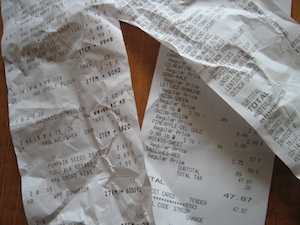 It seems counter-intuitive that eating a healthy plant-based diet costs more then an unhealthy diet full of processed foods. Although cheaper in the short run, the cost savings of eating an unhealthy western American diet is countered as you age with the increase in health costs due to diabetes, heart disease, strokes, autoimmune diseases, and other chronic illnesses.
It seems counter-intuitive that eating a healthy plant-based diet costs more then an unhealthy diet full of processed foods. Although cheaper in the short run, the cost savings of eating an unhealthy western American diet is countered as you age with the increase in health costs due to diabetes, heart disease, strokes, autoimmune diseases, and other chronic illnesses.
But the immediate increase in costs of healthy organic foods can shock the pocketbook, making it a challenge for those living on a tight budget. When given the choice between a cheap, quick, heat and serve processed meal or a slightly more expensive, healthy, make it yourself meal that takes conscious effort, the cheap quick and easy usually wins out.
The good news is eating a plant-based vegan diet doesn’t have to break the bank. According to a study completed at the Harvard School of Public Health in 2013, it only costs about $1.50 more per person per day to eat healthy. It just takes a little strategy to shift your food choices and purchasing habits in order to keep the costs down. Here are some suggestions to help you save money:
-
Limit the purchasing of “super foods”: When my family adopted a plant-based diet our grocery bill more than doubled as we began purchasing high powered nutritious “super foods” like chia and hemp seeds, goji berries, maca root, raw cocoa, etc. The pressure to buy the current trendy health food item that is touted as being a necessity to cure and/or prevent your ailments can be overwhelming. You want the best for you and your family. Sure, those expensive foods may be power packed with nutrients and hold incredible healing properties, but they aren’t a necessity for a healthy diet. Eating healthy is about focusing your food choices on whole natural foods. The truth is; pricier “super foods” aren’t necessary to achieve a balanced, plant-based diet and experience the health benefits. Your everyday produce holds surprising amounts of healing properties. The trick is to consume a variety of fresh produce and whole grains. Check out these great resources:
- Learn about the healthy benefits of eating cruciferous vegetables (broccoli, cauliflower, bok choy, brussel sprouts, kale, collards, etc.)
- Read our blog The Amazing Healing Powers of Beets
- Read our blog Help your body heal: the power of food
- Follow our future blog posts about the nutritional power of everyday produce
-
Think simple: You don’t need fancy ingredients and complicated recipes to enjoy plant-based foods and reap the health benefits. Instead of seeking out those expensive ingredients and complicated recipes, cook meals using everyday grocery items. Enjoy simple vegetable curries over rice, homemade vegetable soups, vegetable stir-fries, veggie & bean chilies, whole grain pasta dishes, and fresh garden salads. They are all tasty and affordable healthy meals. Try one of these recipes:
- Vegan minestrone soup
- Vegan French lentils
- Garlic-ginger beet slaw
- Roasted cauliflower with garlic, ginger and turmeric
- Vegan red lentil soup from Babble.com
- Broccoli slaw stir fry with tofu from Fatfreevegan.com
-
Avoid vegan prepackaged “health” foods and imitation meats and cheeses: Prepared foods will always be more expensive than their non-vegan counterparts. Although they provide convenience and make the transition from meat to meatless a little easier, the costs will bring up your grocery bill.
-
Purchase staple foods in bulk: Staples such as pasta, rice, nuts/seeds, legumes (beans, peas and lentils) and spices are cheaper when purchased in bulk. Purchase at your local wholesale warehouse store like Costco or in the bulk foods isle of your grocery store. Also, watch for sales and then stock up.
-
Focus your organic purchases on the “dirty dozen”: Organic produce is expensive since production costs are higher for organic farmers. If you can’t afford to purchase all organic produce, focus on purchasing organic for those foods listed in the “dirty dozen”, the Environmental Working Group’s (EWG) list of the twelve fruits and vegetables that have the highest pesticide load. Be wary of purchasing produce from outside the country where pesticide regulations may be more lax. And feel confident in purchasing the “clean fifteen”, fruits and veggies deemed by the EWG to be least likely to hold pesticide residue. Before consuming, always wash your fruits and vegetables thoroughly by soaking in 3- parts water, 1-part white vinegar. This will help wash out any pesticide residues.
-
Purchase fresh fruits and veggies in season: Fruits and vegetables not only taste better when eaten in season, but are also cheaper. In their off-season, the stores pass on the expensive transportation costs to the customer by raising prices in order to provide those fresh fruits and vegetables. Purchase produce in season, buying extra to freeze, dehydrate or can for later use. Investigate what’s in season for the area you live. (Produce season for the California Bay area.)
-
Avoid eating out: You will save a lot of money and find it easier to make healthy food choices if you prepare your own food. Cooking gives you total control over the ingredients, especially when trying to limit excess sugar, salt, oil and processed foods. Pack leftovers for lunch for work and homemade muffins, nuts, veggies with hummus, or fruit for snacks.
-
Cook from scratch: Making your own meals without the use of processed foods not only gives you control over all the hidden ingredients and will save you money, but you’ll reap all the health benefits of the whole foods plant-based meal. It may sound time-consuming, but with a bit of re-thinking and learning some new cooking skills, it will become second nature in no time. (Read our blog Eating Healthy; Overcoming the “Cooking Obstacle”.)
-
Grow your own food: Cheaper than canned or frozen, tastes better and you control the pesticide usage. Plant a fruit tree, build a raised bed in a sunny corner of your yard and plant your favorite vegetables, or grow herbs in containers on your balcony or doorstep. You don’t have to have a green thumb. Experiment and have fun with the process of watching plants grow. Check out these resources: How to grow your own food in small spaces and Container gardening for food.
By being mindful about your food choices, you too can reap the benefits of a plant-based healing diet without negatively impacting your budget.

I love reading a post that can make people think. Also, thank you for allowing for me to comment!
Great recommendations! We find the last one to be the hardest to achieve. 😉
Growing your own food can be a challenge, especially if you don’t have any gardening experience. My suggestion is to start simple with a pot of basil in a sunny spot on your windowsill or patio. There is nothing like fresh basil added to a salad or stir fry and it is very easy to grow. 😃